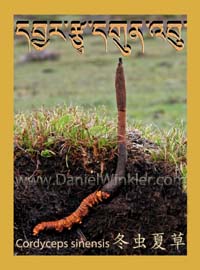Pages on Cordyceps species including Ophiocordyceps , Elaphocordyceps , Cordyceps and their anamorphs (Hirsutella, Isaria etc.) There were over 600 species described as Cordyceps, but then came the genus review by Sung, Hywel-Jones, Sung, Luangsa-ard, Shrestha and Spatafora in 2007 and Cordyceps was divided into Cordyceps, Ophiocordyceps, Elaphocordyceps and Metacordyceps. All Ophiocordyceps species including Ophiocordyceps sinensis were placed in the new family Ophiocordycipitaceae. Reference: Sung, G. H., N. Hywel-Jones, J. M. Sung, J. J. Luangsa-ard, B. Shrestha, & J. Spatafora. 2007. Phylogenetic Classification of Cordyceps and the Clavicipitaceous Fungi. Studies in Mycology 57:5-59. When looking for Cordyceps / Ophiocordyceps sinensis please visit my "Cordyceps Corner" | ||
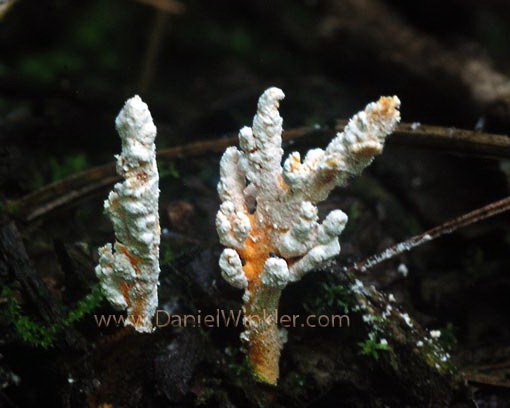 Thin-stemmed Isaria (Isaria tenuipes), an anamorph of Cordyceps was growing on a larva in the woods below Chari Goenba. The white powder are conidia, cells that function like spores in Cordyceps anamorph. © Daniel Winkler, near Chari Gonpa, Bhutan, Sept. 2009 | 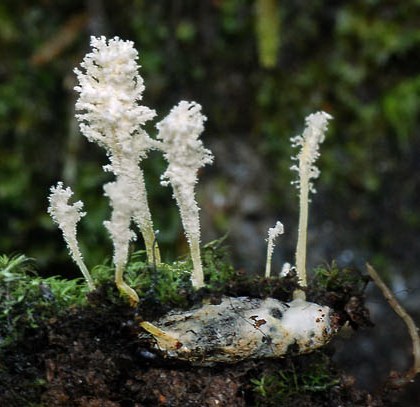 Another Isaria species growing in the same location. Here the mummified insect has been exposed. The insect was killed by the Isaria fungus and serves as nutritional base. © Daniel Winkler, near Chari Gonpa, Bhutan, Sept. 2009 | |
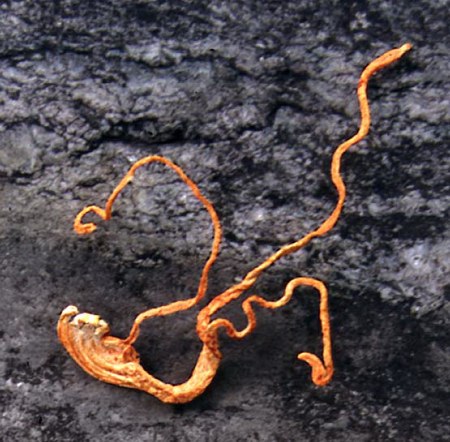 A dried specimen of cultivated Cordyceps militaris. Cultivators have managed not only to grow the mycelium as in the case of Ophiocordyceps sinensis, but are able to induce stroma growth [which has been claimed falsely for the in early 2010 for O. sinensis]. Artificial cultivation has made C. militaris a much more affordable alternative to O. sinensis. Photo: May 2004 © Daniel Winkler | Cordyceps militaris 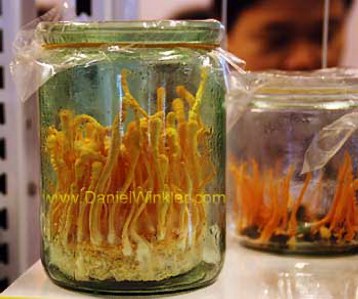 Cordyceps militaris cultivated on bred larvae shown at the IMMC5 exhibition. In early 2010 in the UK a research article was published demonstrating how Cordycepin, one of the active ingredients in Cordyceps militaris [and O. sinensis], is succeeding in stopping cancer cell reproduction. Photo: Nantong, September 2, 2009 © Daniel Winkler | |
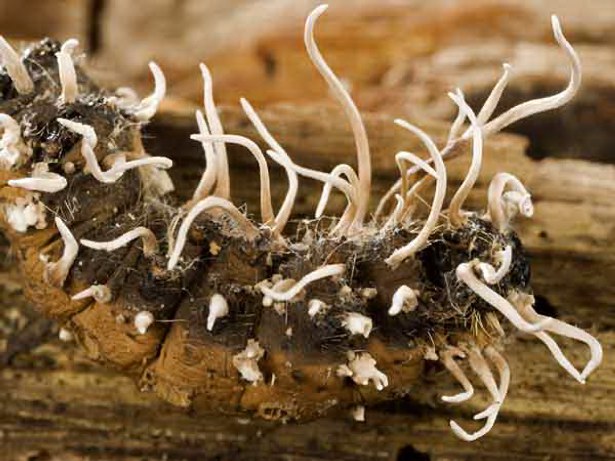 Larry Millman found this larva near Boston. The larva (length 2.7cm), probably of a tussock moth, has been infected by Hirsutella, an anamorph of Ophiocordyceps, according to Kathie Hodges, mycology professor at Cornell. Joe Warfel took these great photos. Joe is into macro photography. Copyright: J. Warfel, April 2010 |
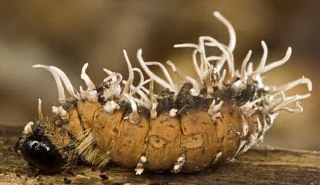 | |
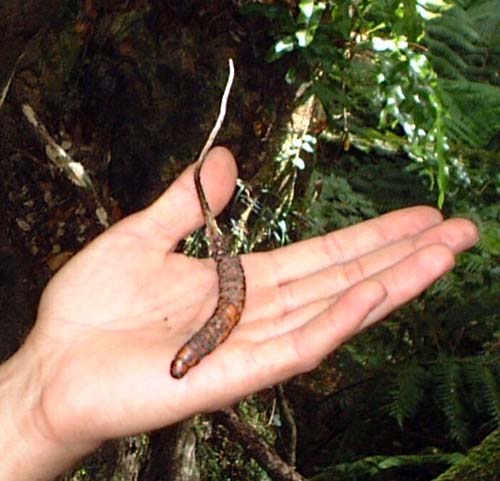 Ophiocordyceps robertsii from New Zealand where it is known as awheto or aweto by the Maori. The Maori people burn this caterpillar fungus and use the ash as tattoo ink. "Aweto" is also sometimes used in "Chinglish" when Chinese English-language articles report about caterpillar fungus (Ophiocordyceps sinensis) in Tibet or China. Ophiocordyceps robertsii from New Zealand where it is known as awheto or aweto by the Maori. The Maori people burn this caterpillar fungus and use the ash as tattoo ink. "Aweto" is also sometimes used in "Chinglish" when Chinese English-language articles report about caterpillar fungus (Ophiocordyceps sinensis) in Tibet or China. Photo: Regi, Whenua | Dave Nevin from New Zealand shared the following information on Ophiocordyceps robertsii : I was reading an account by the American Consul to New Zealand, John B. Williams, 1844...and thought you might be interested. "The Hotte a decided Caterpillar or worm, is found growing at the foot of the Rata tree with a plant growing out of its head; some have said that this peculiar and singular insect travels up the tree, both the rata & perriri [puriri] trees, and entering into the top burrows or eats its way through the trunk of the tree until it reaches the root; it then comes out of the root and dies or remains dormant and the plant propagates out of its head, the body remains perfect and entire of a harder substance than when Source: p.109. The New Zealand Journal, 1842-1844 of John B. Williams of Salem, Massachusetts http://nzetc.victoria.ac.nz/tm/scholarly/tei-WilNewZ-t1-g1-t2-body-d1-d3.html Dave also writes: I know of Puriri Moth, a large green nocturnal that occasionally flies in my window, it will bore lots of half-inch holes in the living tree. Note: Rata tree is in the Genus Metrosideros, Myrtaceae |
Page erected May 1, 2010, Last update 3-1-2014 | |

